| 1 | Earth’s longest snake |
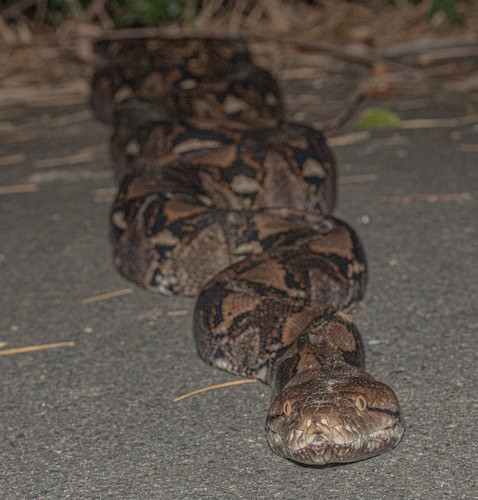
It’s interesting when a new blood pressure medication is extracted from a jararaca in Brazil, or a rattlesnake is found to coil lovingly around its newborns. But the question everyone really cares about is Earth’s longest snake species, and the official winner of the 3900 worldwide is the reticulated python.
This species is extremely widespread in southeast Asia. Their range begins in southern Bangladesh (skipping India), and spreads through most of Thailand, Vietnam and Cambodia. They cover all of Malaysia, and most Indonesian islands except for New Guinea.
Though anacondas are thicker and heavier, and African rock pythons eat larger meals (like impala), reticulated pythons are undoubtedly the world’s longest snake, both in their average length and all-time record. They’re believed to occasionally exceed 7 metres in the wild, and the captive record measured 7.67 metres (Medusa in Kansas City).
Reticulated pythons are relatively flexible in urban habitats, and often slither down streets, forcing people to jump over. They poke their heads up from storm drains in Singapore, slither into 7/11s in inner city Bangkok, and in May 1897, a reticulated python was found in the Thai king’s palace. They were especially common in Bangkok in the early 20th century, amid bustling rice mills, the racket of timber sawing and the constant unloading of ships. But they’re still found lurking discreetly in the city today, in the age of cars and air pollution.
Like other pythons, reticulated pythons are a crushing constrictor with no venom. They have smooth scales and long, recurved teeth which hook into prey and are almost impossible to remove once attached.
| 2 | Tales of giga-pythons |
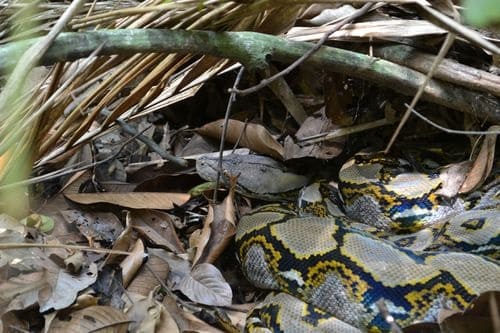
Reticulated pythons are regularly found with adult monkeys, pigs and deer in their stomachs. Like with the green anaconda of South America, debating their exact maximum size has become an international sport. With British and French colonists having a strong presence in southeast Asia, there’s a long list of wild and unsubstantiated records in old logbooks, ranging from 25 to 30 to even 40 feet (12.2 metres).
A classic case happened in 2004, involving a python kept in a zoo in Indonesia, which apparently measured 14.85 metres. The giga-python supposedly ate “four fierce dogs every month” and took 65 men to capture, plus the blessing of a tribal leader. It was originally captured at 19 metres in 2002, before 4 metres had to be severed due to a rotten deer in its stomach. A journalist was dispatched with a tape measure, and came up with a respectable, but less extreme measurement of 6-7 metres. The zookeepers insisted it had shrunk.
Like with anacondas, some huge records have actually been skins, like a reticulated python from Borneo which carried off a dog and was killed by the dog’s owner, whose skin measured 24 feet. Skins tend to stretch when seperated from snakes’ bodies.
| 3 | The official captive record |
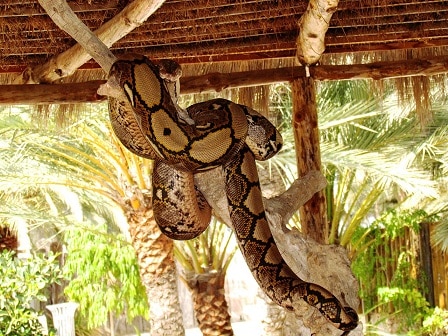
Dutch zoologist Nelly de Rooij stated in 1917 that reticulated pythons sometimes exceed 9 metres. In 1899, Ridley wrote about a python measuring 40 feet “obtained by a scientific expedition in Manila“. Guinness World Records currently has the record as a 10 metre reticulated python caught in Celebes, Indonesia, in 1912. The snake was killed by natives at a mining camp, and measured by a civil engineer using a surveying tape.
The monstrous snake was originally listed as 32 feet 9.5 inches, but someone somewhere rounded it to 33 feet, and then 10 metres, which has been the figure circulating ever since. Points in favour are that a live snake (not a skin) and scientific measurements were apparently used. However, the only evidence produced was a blurry photograph, which has since been lost.
The longest officially verified reticulated python ever was a captive named Medusa, who lived at a horror attraction in Kansas City. When measured in October 2011, the python required 15 men to hold her. The result was a whopping 7.67 metres, and a weight of 350 pounds. Medusa was kept alive on a diet of hogs, rabbits and deer, and typically ate a 40 pound deer in one sitting. Medusa was said to purr when relaxed and hiss when angry, and even outstretch herself and stay still when the attraction was open.
| 4 | Can go 18 months without eating |
Dotted around, there are old records which lack 100% photographic (or preserved snake) proof, but come from fairly esteemed and reputable sources. According to Dr. Wilson, senior medical officer in Johore, a python killed in Muar, Malaysia in 1889 measured 6.85 metres, with a 22.8cm diameter.
In 1929, the Field Museum of Natural History in Chicago sponsored an expedition to Sumatra, where the expedition leaders found a male reticulated python measuring 24 feet (7.3m), and a female measuring 21 feet (6.4m). The latter contained 81 eggs. An 1892 expedition organized by the Minnesota Academy of Natural Sciences found two huge snakes in the Philippines, both measuring approximately 6.9 meters.
In 1899, a man apparently ripped up the wooden floors of his stables in Bangkok, and found a 6.09 metre reticulated python sleeping below, which is believable. One theory is that modern reticulated pythons are smaller due to overhunting, as large individuals are more highly prized.
Another freakish thing is their ability to fast. As reported in 1928, a captive reticulated python in London’s Regent’s Park zoo went 1 year and 11 months without eating a meal. When it resumed feeding, it carried on like nothing had happened.
| 5 | The confirmed wild record |
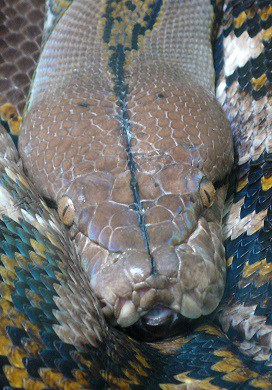
The largest official documented wild reticulated python, at least in the modern era, was measured on Indonesian Borneo in 1999. Scientists were originally tracking a Malayan sunbear, a female weighing 50 pounds, which was unusually thin due to fruit shortages. She was estimated at over 10 years due to her ground-down canine teeth, and she was monitored on a daily basis.
On July 30th, she was found to be active, but the next morning, the radio signal had moved to 550 metres away, and then hadn’t moved for 4 hours. The scientists tracked the radio-collar to a swamp, and instead of a bear, they found a large reticulated python curled up under a thicket. There was a large bulge 2 metres from the python’s head, and no signs of injury on the python.
When poked with a stick, the reticulated python fled into the bushes, producing a brutal sound of breaking bones as it twisted. The python then moved into a shallow stream, and a large hollow log. It spent 26 days inside this log sanctuary, digesting its bear meal in comfort.
The python was taken into captivity, where it successfully digested the bear. On October 29th 1999, the radio transmitter was removed from its body. Finally, the moment of truth: with no meal in its body, the reticulated python was found to measure 6.95 metres, with a weight of 131 pounds.
| 6 | Pigs: their riskiest meal |
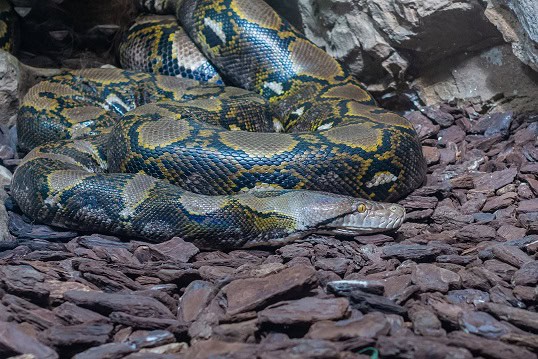
Like any huge snake, there’s many a tall tale, or fairly believable tales, of enormous meals. Robert Shelford was a British naturalist based in Borneo. In 2019, he described seeing a 5.5 metre reticulated python which had just swallowed a pig. It was a grotesque sight, as the python’s mid-section was severely distended, almost to bursting point. The python’s scales were no longer side by side, but stretched well apart. The skin between was pulled so taut that the pig’s hairs were clearly visible below.
In another incident, the pigs emerged victorious. Near Sanctubong, there was a deafening noise of wild pigs, with their usual squealing and grunting. The trigger was a large reticulated python with a young pig trapped in its coils, beginning to apply its crushing pressure. The adult pigs reacted with fury, and were goring the python with their tusks, trampling it into the earth. They were so aggressive that the python was forced to relinquish its grip. The pig herd then left the area, including the rescued youngling, acting casual like nothing had happened. The reticulated python was so mangled and ruined that it was unable to move.
Deer also recognise them as a threat; when a python was brought past the paddock of a deer herd, they gathered closely together and started stamping their feet.
| 7 | Takes on leopards and stags |
Frank Buck, famous 1930s naturalist and author of Bring ‘Em Back Alive, took an unexplained photo of a reticulated python coiled around a tiger. He also described how he found a “huge” python by a forest game trail, and ordered several locals to drive a black leopard from the forest into its clutches. Buck waited patiently, and soon heard the sounds of cracking twigs and rustling leaves. The black leopard approached cautiously, not comprehending the serpent danger.
Some instinct kicked in and the leopard stopped, but it was too late, and the reticulated python pounced. It hooked its long fangs in, and instantly began applying its crushing coils in a smooth manouvre. The leopard let out a blood curdling scream, and slashed the python’s body wherever it could. However, it was no use, and the leopard died 4 minutes after first contact. Buck described it as “the law of the jungle in its most savage manifestation“.
In Sumatra in 1932, Buck bumped into some Eurasians who had killed a huge reticulated python. He slit its stomach, and out tumbled a sambar stag measuring 160 pounds, whose antlers had been broken and folded down to be consumed more easily.
| 8 | A good climber at all ages |
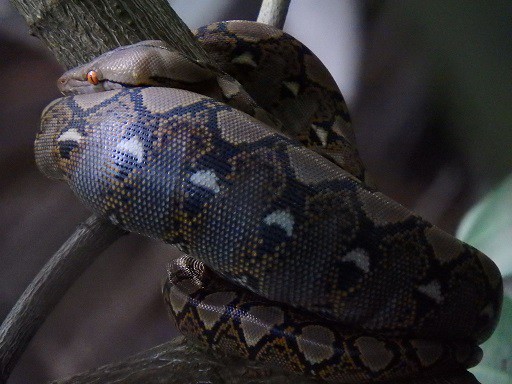
Most research focusses on the reticulated python’s enormous size, and there’s large gaps about their natural lifestyle, away from towns. They seem to correlate with water bodies, such as marshland and swamps, and we know they like to rest for weeks inside long hollow logs. A 2004 report from Thailand found a new secret of the species.
Scientists found 8 juvenile reticulated pythons measuring 1-2 metres by a mangrove creek on Tarutao Island, and a further 4 in Kaeng Krachen National Park, plus a 3 metre adult. The adult was found coiled under a large tree in overgrown vegetation. However, all 12 juveniles were found resting on branches above water, ranging from 2-15 metres high, with most favouring the higher branches. The mangrove creek and river had several shallow points, yet every reticulated python was positioned over deep waters.
The scientists alerted 10 of the 12 pythons, and each one instantly dropped from its branch, plunging into the deep water. Not one attempted to escape along the branch, or bridge to another branch. This instant release is similar to the USA’s brown watersnake, which is constantly dropping on fishermen’s heads in swamps.
| 9 | The booming worldwide trade |
Reticulated pythons are one of the most heavily traded reptiles in the world, perhaps ranking first, mainly due to fashion outlets transforming their skins into leather products. Each year, Malaysia and Indonesia export 300,000 of an estimated 450,000 worldwide.
In a vast network, local villagers trap and catch the snakes, who sell them to middlemen, who in turn sell them to mass tanneries. There’s also breeding facilities dedicated to exporting reticulated pythons, particularly in Vietnam. Certain regions have specific quotas. Sabah state (Malaysia) once had a quota of 12,000 exports, which was reduced to 3000 in 2013.
Originally, the EU was the largest importer, but the commission banned the import of Malaysian reticulated python skins in 2004. This was partly rescinded in 2016, but reinstated in 2019, before being upheld in 2021, while dubbing the trade “unsustainable by all assessments“. Some believe that bans are actually putting more pressure on the species, as hunters are forced to sell their catch to less profitable Asian markets, thus forcing them to sell higher numbers to maintain their income. Reticulated pythons cover so much territory that extinction is almost impossible, but they’re probably declining sharply in certain regions.
| 10 | Eaten by king cobras occasionally |
As for their wild predators, there’s a small handful that dare to have a go, including saltwater crocodiles, the heaviest reptile on Earth. A 2015 photograph shows one snapping down on a reticulated python in Malaysia’s Lower Kinabatangan Wildlife Sanctuary. The king cobra can also prey on smaller individuals. In 1949, a 366cm king cobra was documented preying on a 279cm reticulated python, which is probably the largest confirmed snake-on-snake prey ever recorded.
Reticulated pythons are also masters of overseas travel. They can be found many miles offshore, and have colonised numerous offshore islands such as the Natuna Islands, Mentawai Islands, and Banda Islands. Several of these have shrunk and become dwarf forms, such as the Tanahjampean reticulated python, a subspecies which rarely exceeds 2 metres.
Due to their comfort in human zones, they often stowaway on ships. In 1907, for example, a reticulated python was found alive in London’s Albert Docks, and given a new home in Regent’s Park zoo.
